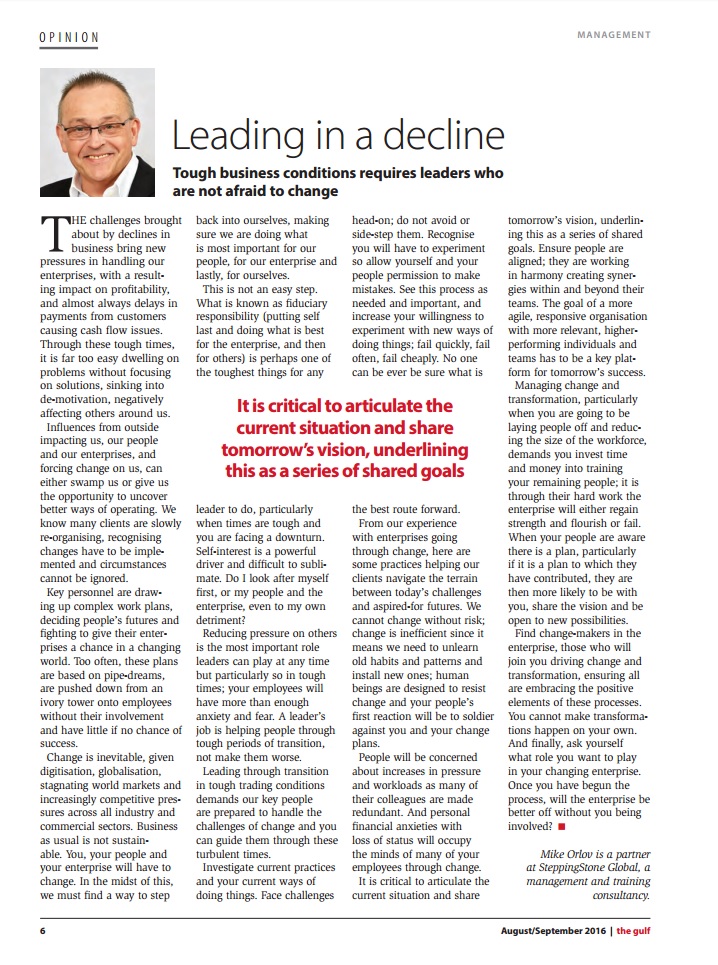
Leading in a Decline
The challenges brought about by declines in business bring new pressures in handling our enterprises, with a resulting impact on profitability, and almost always delays in payments from customers causing cash flow issues. Through these tough times, it is far too easy dwelling on problems without focusing on solutions, sinking into de-motivation, negatively affecting others around us.
Influences from outside impacting us, our people and our enterprises, and forcing change on us, can either swamp us or give us the opportunity to uncover better ways of operating. We know many clients are slowly re-organizing, recognizing changes have to be implemented and circumstances cannot be ignored.
Key personnel are drawing up complex work plans, deciding people’s futures and fighting to give their enterprises a chance in a changing world. Too often, these plans are based on pipe-dreams, are pushed-down from an ivory-tower onto employees without their involvement and have little if no chance of success.
Change is inevitable, given digitization, globalization, stagnating world markets and increasingly competitive pressures across all industry and commercial sectors. Business as usual is not sustainable. You, your people and your enterprise will have to change. In the midst of this, we must find a way to step back into ourselves, making sure we are doing what is most important for our people, for our enterprise and lastly, for ourselves.
This is not an easy step. What is known as fiduciary responsibility (putting self-last and doing what is best for the enterprise, and then for others) is perhaps one of the toughest things for any leader to do, particularly when times are tough and you are facing a downturn. Self-interest is a powerful driver and difficult to sublimate. Do I look after myself first, or my people and the enterprise, even to my own detriment?
Reducing pressure on others is the most important roles leaders can play at any time but particularly so in tough times; your employees will have more than enough anxiety and fear. A leader’s job is helping people through tough periods of transition, not make them worse.
Leading through transition in tough trading conditions demands our key people are prepared to handle the challenges of change and you can guide them through these turbulent times.
Investigate current practices and your current ways of doing things. Face challenges head-on; do not avoid or side-step them. Recognize you will have to experiment so allow yourself and your people permission to make mistakes. See this process as needed and important, and increase your willingness to experiment with new ways of doing things; fail quickly, fail often, fail cheaply. No one can be ever be sure what is the best-route forward.
From our experience with enterprises going through change, here are some practices helping our clients navigate the terrain between today’s challenges and aspired-for futures. We cannot change without risk; change is inefficient since it means we need to unlearn old habits and patterns and install new ones; human beings are designed to resist change and your people’s first reaction will be to soldier-against you and your change-plans.
People will be concerned about increases in pressure and workloads as many of their colleagues are made redundant. And personal financial anxieties with loss of status will occupy the minds of many of your employees through change.
It is critical to articulate the current situation and share tomorrow’s vision, underlining this as a series of shared goals. Ensure people are aligned; they are working in harmony creating synergies within and beyond their teams. The goal of a more agile, responsive organization with more relevant, higher-performing individuals and teams has to be a key platform for tomorrow’s success.
Managing change and transformation, particularly when you are going to be laying people off and reducing the size of the workforce, demands you invest time and money into training your remaining people; it is through their hard work the enterprise will either regain strength and flourish or fail. When your people are aware there is a plan, particularly if it is a plan to which they have contributed, they are then more likely to be with you, share the vision and be open to new possibilities.
Find change-makers in the enterprise, those who will join you driving change and transformation, ensuring all are embracing the positive elements of these processes. You cannot make transformations happen on your own. And finally, ask yourself what role you want to play in your changing enterprise. Once you have begun the process, will the enterprise be better off without you being involved.
